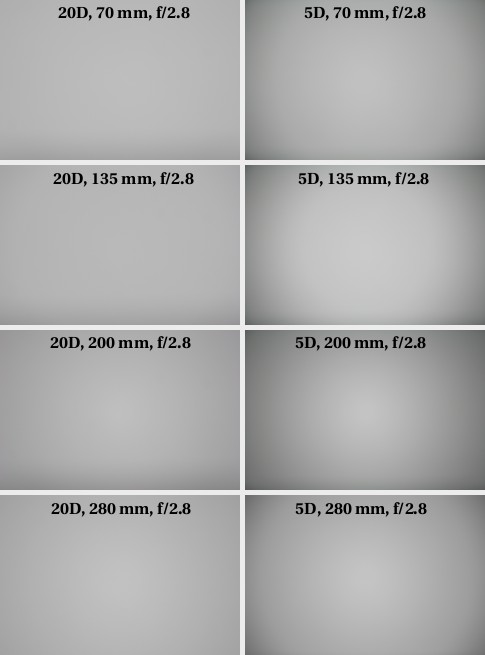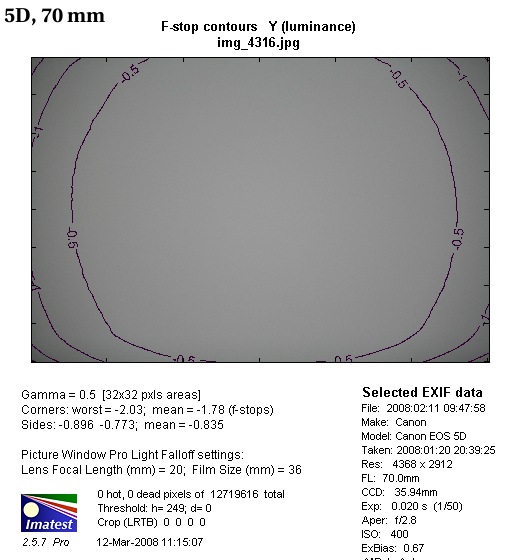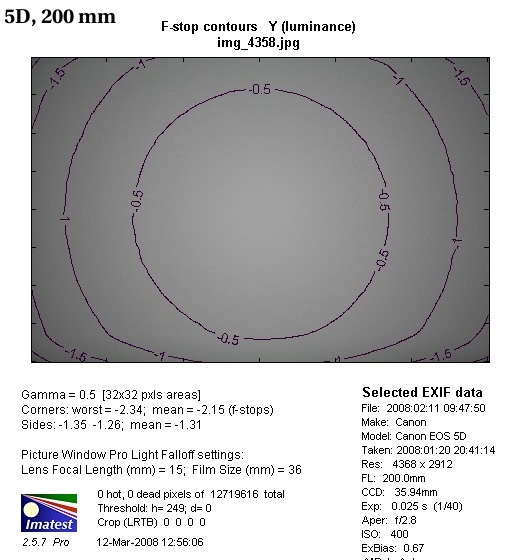Canon EF 70-200 mm f/2.8L USM
8. Vignetting

At the shortest focal length that aberration is difficult to notice even wide open and its level was measured by us as 12% (-0.37 EV). On stopping down to f/4.0 the vignetting decreases to a negligible value of 4%.
Please Support UsIf you enjoy our reviews and articles, and you want us to continue our work please, support our website by donating through PayPal. The funds are going to be used for paying our editorial team, renting servers, and equipping our testing studio; only that way we will be able to continue providing you interesting content for free. |
- - - - - - - - - - - - - - - - - - - - - - - - - - - - - - - - - - - - - - - - - - - - - - - -
The situation is a bit worse at 135 mm focal length where, by f/2.8, the light fall-off in the frame corners amounts to 15% (-0.47 EV). Once again when we stop down to f/4.0 we eliminate the problem completely (4%).
The biggest chances to actually see the vignetting we have at 200 mm. It reaches the level of 25% (-0.83 EV) at the maximum relative aperture. Fortunately once again on stopping down to the f/4.0 aperture we make this aberration decrease to an unobtrusive value of 10%.
Using the converter helps to fight vignetting efficiently because by f/4.0 it is 16% and by f/5.6 it decreases to only 3%.
On the full frame sensor of the Canon 5D the situation is totally different, though. Here the vignetting is visible at all focal lengths and reaches high values. At 70 mm and by f/2.8 the brightness loss in the frame corners amounts to 45% (-1.74 EV). On stopping down to f/4.0 it decreases to 23%. By f/5.6 it is still at the level of 15% and only by using the aperture of f/8 we see the problem disappear completely (8%).
The situation at 135 mm is very similar. There, at the maximum aperture, the aberration reaches the level of 50% (-2.0 EV). On stopping down to f/4.0 we see it decreasing to 30% and by f/5.6 it amounts to 23%. The vignetting becomes imperceptible only near f/8 and f/11 where it is 14% and 8% respectively.
The longest focal length seems to be the weakest point. The vignetting at the maximum aperture reaches as much as 53% (-2.16 EV). It decreases on stopping down – by f/4.0 it amounts to 31%, by f/5.6 – 20%, by f/8.0 – 13% and by f/11 - only 7%.
Again using the converter helps fighting against this aberration. By f/4.0 we notice a light fall-off in the frame corners of 44% (-1.7 EV). By f/5.6 the vignetting decreases to 20% and by f/8.0 it disappears completely (3%).
 |
 |






